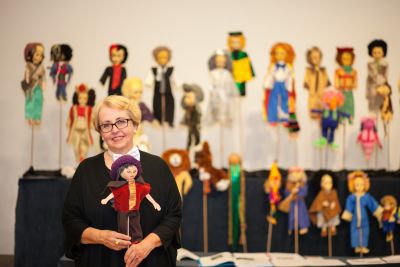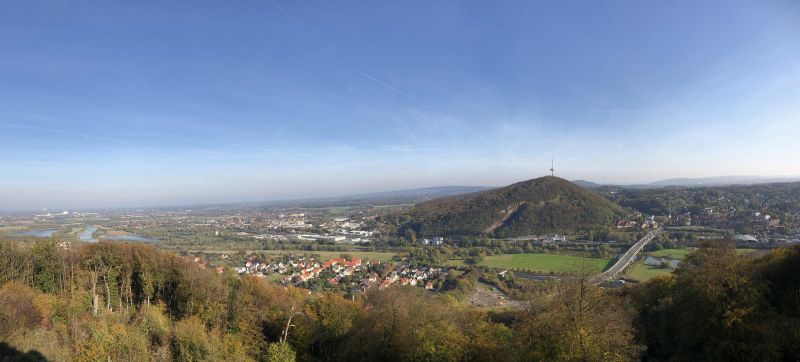Tales from the hills. The fate of Polish forced labourers at Porta Westfalica 1944/45
Mediathek Sorted






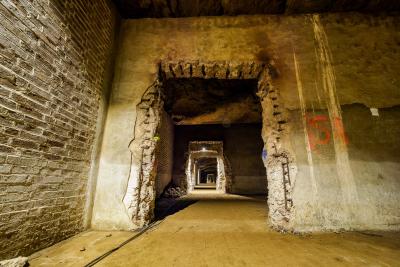
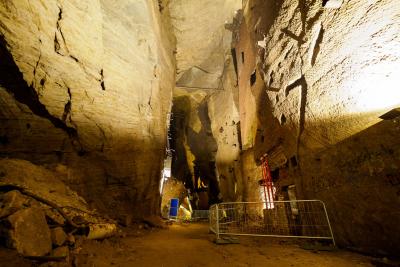

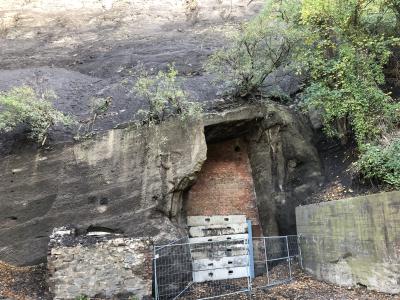

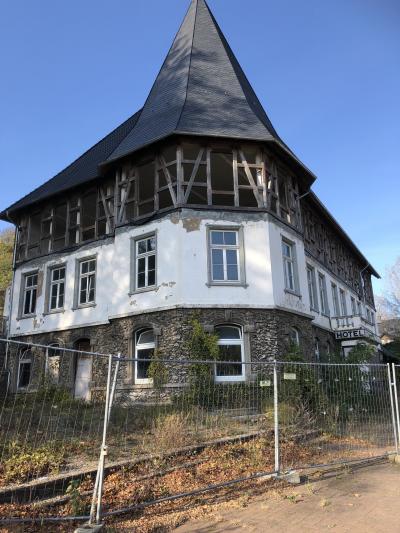

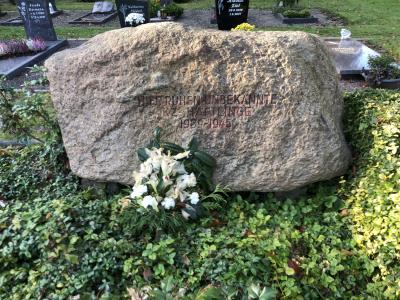

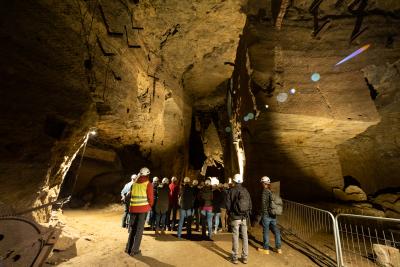

Introduction
The picturesque town of Porta Westfalica in the north-eastern region of North Rhine-Westphalia, with its unusual, Latinised name – a direct reference to the location of the town at the “gate to Westphalia” – is known locally simply as “Porta”. The enormous monument to Kaiser Wilhelm I towers over the town’s district of Barkhausen. The famous landmark in the region rises up from the Wittekindsberg hill and offers a breathtaking view onto the river Weser, which cuts through the idyllic Wiehen and Weser hills (Fig. 1 ). When I first visited the town in the autumn of 2019 and took in the view over other parts of Porta Westfalica from the large terrace that runs around the monument, it was difficult to imagine that here, in the middle of this beautiful landscape, several thousand people were forced to perform hard labour for the National Socialist regime. During the final years of the Second World War, Barkhausen, Hausberge and Neesen, which today belong to Porta Westfalica but which were at that time independent villages, were used as satellites for the Neuengamme concentration camp near Hamburg. Several of these satellites were constructed simultaneously in order to support a major armament production campaign involving a large number of big companies such as Philips from the Netherlands and the Deurag-Nerag oil refinery in Hanover. The forced labourers themselves were astonished at the location chosen for the production facilities. The former concentration camp inmate Wiesław Kielar remembers arriving at the Porta:
“We were disembarked from the train at the goods station of a small town with the strange name ‘Porta Westfalica[1]’. We were all the more surprised when we saw this quiet little town that ran along hillsides on both banks of the river with its typical holiday houses, without any trace of industrial activity. Where were the Philips factories where we were supposed to work?”[2]
The prisoners only found out that these factories, like many others used to support the National Socialist war economy, were to be located underground when they arrived on site. These “U-Verlagerungen” (underground relocations) were assigned codenames and were kept strictly secret. From 1943 onwards, the National Socialists moved these armament production sites, which were of great importance to the war effort, underground to protect them against Allied bombing raids. Although sandstone quarries had already been dug in the hills around the Porta in the past, they first had to be expanded before factories supporting the war effort and armament production could move in. This expansion involved a great deal of hard labour. The plan was extremely ambitious, and demanded one thing above all else: a workforce. Many of the foreign forced labourers brought to the Porta were forced to pay with their lives, although even today, the precise number of those who died is still not known.
Since the founding of the KZ-Gedenk- und Dokumentationsstätte Porta Westfalica e. V. in 2009, interest in keeping the memory of the forced labourers alive has increased in the region, and has meant that the darkest chapter of German history is not being forgotten.
What did the underground factories at Porta Westfalica look like? What source materials and personal memories have been passed down? What were the working and living conditions like for the concentration camp inmates who were forced to toil underground at the Porta? The aim of my historical research is to examine the traces of the National Socialist armament production and to find out more about the fate of the Polish forced labourers in Porta Westfalica.
Strategic aerial warfare, the founding of the “Jägerstab” programme, and the transfer of factories underground: historical background
From 20 to 25 February 1944, in what was known as the “Big Week”, the Allies conducted a series of air strikes on sites used to produce armaments by the National Socialists. The focus of the bombing raids was the destruction of German aircraft production sites, with the overriding goal of dealing a decisive blow to the Luftwaffe.[3]
The targeted air strikes did indeed have a major impact. Production of the fighter planes in particular, which were essential for the defence of the German Reich, was severely hampered. The response of the NS regime was swift: as early as 1 March 1944, on the initiative of the Reich Air Ministry (Reichsluftfahrtministerium) and the Reich Ministry for Armament and War Production (Reichsministerium für Rüstung und Kriegsproduktion), the “Jägerstab” aircraft production committee was founded.[4] This group was tasked with taking measures to guarantee the protection and uninterrupted production of the aviation and air force industry:
“To secure the Jägerpogramm [fighter aircraft programme], the ‘Jägerstab’ will be created with immediate effect by the Reichsminister für Rüstung und Kriegsproduktion [Reich Minister for Armament and War Production], for the duration of 6 months. Its objective is to repair damaged factories [of the aviation and air force industry; author’s note], or to implement their relocation, without bureaucratic impediments and by issuing direct orders. This measure – in particular insofar as it pertains to construction work – takes priority over all other measures that have been regarded as being of particular importance in recent times. (...) The Jägerstab shall build satellite locations for the production sites in question.”[5]
The wording of the order regarding the establishment of the Jägerstab reflects the acute urgency felt by the National Socialists when it came to taking protective measures for the war industry at this point in time. The members of the committee immediately decided to relocate the aviation and air force production sites to rural regions which would be less affected by Allied bombing raids. If possible, the sites were even to be moved underground. This Herculean task demanded a huge labour force which could not be provided by German citizens alone. It was already becoming necessary to replace those Germans working in different areas of industry who had been called up to fight or who had been killed at the front, with the result that the number of German workers available continued to decline. At the same time, however, after the turning point in the war in the winter of 1941/42, the need for armament equipment increased, and the relocation of industrial sites that were important for the war effort in the spring of 1944 made it all the more urgent to find more workers. To compensate for the dwindling labour force, the National Socialist regime systematically made use of prisoners of war, concentration camp inmates and civilians from abroad, who were employed as forced labourers, including for the underground relocation:
“(...) Insofar as the measures pertain to the acquisition of bomb-proof production facilities in larger caves or new mine tunnels, the Reich Minister for Armament and War Production [Reichsminister für Rüstung und Kriegsproduktion] shall involve the Reichsführer SS in the implementation of the required construction measures. (...) The Reichsführer SS shall provide protective custody prisoners in sufficient numbers to assist in the construction and production”.[6]
Heinrich Himmler, the Reichsführer SS, was therefore personally responsible for providing labourers for the relocations. Hans Kammler, SS-Gruppenführer and engineer, who at that time was head of Department (Amtsgruppe) C (construction) in the SS Main Economic Policy Office (SS-Wirtschaftsverwaltungshauptamt), had already worked on other relocations, where he was noted for his complete disregard for the lives of the forced labourers. Kammler was ordered by the Armament Minister (Rüstungsminister) Albert Speer to lead the construction of the new underground sites.[7] To implement this special construction order, Kammler established his own construction organisation under his name, and ordered that the regional relocation projects, including the one at Porta, be subject to individual special inspections by the SS.[8] SS Special Inspection (Sonderinspektion) I, headed by the engineer Bernhard von Glisczynski, was responsible for the relocation work at the Porta.[9] The power of the Jägerstab to issue direct orders and the involvement of important representatives from the armament industry, the war ministry and the SS meant that work could start quickly on relocating the sites. This had immediate consequences for the “Gate of Westphalia”: it was decided just three days after the Jägerstab was founded that production sites should be relocated to the hills surrounding the Weser river. As a result, during the final two years of the war, several thousand labourers were put to work in the NS armament production sites at Porta Westfalica.[10]
“Concentration camps in the neighbourhood” – the satellite camps at the Porta
During the Second World War, the area now covered by the town of Porta Westfalica contained a total of three satellites of the Neuengamme concentration camp near Hamburg. They were built in Barkhausen, Hausberge and Lerbeck/Neesen – all town districts which at that time were still villages in their own right and which belonged to the Hausberge and Dützen district authorities. It was not until the local government reorganisation on 1 January 1973, when local authorities and communities in the Bielefeld restructuring area were reorganised by law, that these villages, along with others, became part of what is now Porta Westfalica.
The satellite camps were built very soon after the decision of the Jägerstab – right next door to the local German population.
The first train carrying the forced labourers for the underground relocation, codename “Max I”, contained 300 male inmates from the Buchenwald concentration camp. It reached the Porta on 18 March 1944. From registration cards and the prisoner personnel forms of the concentration camp inmates, it has been possible to identify the names of 19 people of Polish origin on this first train.[11] The historian Thomas Lange from theKZ-Gedenk- und Dokumentationsstätte Porta Westfalica e. V. association points out a noticeable accumulation: a large number of Polish prisoners on the first train to the Porta had been brought to Buchenwald concentration camp on the same date, 24 February 1944. The question arises as to whether there is a connection between the date of incarceration at Buchenwald and the use of that same group of people at the Porta – a question that current research has as yet been unable to answer.
To accommodate this first group of forced labourers, the SS converted the large banquet hall of the “Kaiserhof” luxury hotel in Barkhausen into a satellite camp, the running of which was assigned to SS-Obersturmführer Hermann Wicklein.[12] At the start of the 20th century, the hotel, with its favourable location directly by the train station and the Weser river, and its view onto the Kaiser Wilhelm Monument built in 1896, was highly popular with tourists and housed a large number of guests. (Figs. 2 and 3 ).[13]
The camp in Barkhausen was not only the first, but also the largest of the three satellites. In addition, this is the camp about which the most information is available, since many of the concentration camp inmates later wrote accounts of their time there.[14] Wiesław Kielar, for example, described his impressions on arriving in the hotel banquet and theatre hall:
“Curious, I looked around the spacious theatre hall, which had very clearly been converted into a small concentration camp. The ceiling of this high room, where traces of paintings could be seen, was supported by ornamental beams, which were in turn supported by heavy pillars designed to imitate Greek columns. The row of these columns separated the centre of the room, or the muster ground, from the rows of four-tier beds, which had been set up on both sides along the walls, which had windows of several metres in size; the windows had been fitted with sheet metal shutters and thick grating, which was intended to provide dubious [sic!] protection against any attempt at escape”.[15]
Henryk Stróżyk, another Polish concentration camp inmate in Barkhausen, also gave a vivid impression of the satellite camp building:
“Round about [the camp building; author’s note] there was barbed wire, and watchtowers stood on the corners. The hall was very large. In the middle, there was a muster ground, and surrounding it were four-tier beds made of wood. On the walls there were large windows with fold-out shutters made of sheet metal, which had thick wire mesh. On the stage, the podium, were the beds used by the senior prisoners and the foreman. There was no heating, and it was just as cold inside the building as it was outside”.[16]
Over the entire period during which forced labourers were used at the Porta, appoximately 1,500 male prisoners were housed in the around 40-metre long, 25-metre wide and 5-metre high hall building (Figs. 4 and 5 ).[17] Four-tier rows of beds were set up as sleeping quarters, with two people having to share one small bed of just 1.80 x 0.70 metres.[18] In addition to the grilles on the windows, the entire camp building was surrounded by barbed wire to prevent the inmates from escaping. The prisoners suffered from malnutrition due to the insufficient rations and the poor quality of the food. To avoid emaciation and starvation, they were dependent on finding additional food elsewhere, which in some cases was secretly passed to them by members of the local population.[19]
The second of the three satellite camps at the Porta was built in the autumn of 1944 on the right bank of the Weser in the territory of the former village of Neesen, directly opposite Barkhausen. However, this camp, Lerbeck, was not named after the place in which it was situated, but rather after the place in which the work was to be conducted.[20] Here, a total of around 500 male prisoners from different countries were interned, first under the command of SS-Unterscharführer Heinz Rast, and later under SS-Oberscharführer Richard Emanuel Eichler.[21] There is evidence to prove that in this camp, too, the inmates suffered from malnutrition, as well as from the violence and harassment meted out by the SS camp command. For example, according to an account by Hermann Langbein, a prisoner at Lerbeck, one Belgian inmate was murdered in a particularly brutal fashion by camp commander Eichler through blows to the skull.[22] Research into the camp to date has found evidence of 34 deaths at the Lerbeck/Neesen satellite camp, although it is likely that the real figure is higher.[23]
The third satellite camp was established at the start of 1945 on Frettholzweg in Hausberge. It was used mainly for Jewish women from the Netherlands and Hungary, who had been deported to the Porta from Auschwitz concentration camp, from Horneburg, a satellite of the Neuengamme concentration camp, and from Reichenbach, a satellite of Gross-Rosen concentration camp. Around 1,000 women were interned in the Hausberge camp. They were made to work underground, producing radio tubes for Philips.[24] They, too, suffered from harassment in their camp. In some cases, they were even subjected to severe maltreatment from female guards.[25] Relatively little is known about this camp and the lives of the prisoners there compared to the other two.
All three satellite camps were cleared on 1 April 1945 – just five days before the Allied troops crossed the Weser line and liberated the villages at the Porta. The male prisoners from the camps in Barkhausen and Lerbeck/Neesen were taken on two trains to the camp at Wöbbelin, where they were finally liberated by US troops at the start of May 1945. It is harder to reconstruct the journey made by the female prisoners from the Hausberge camp after it was cleared and, in particular, where they were taken to. Currently, we can only draw conclusions about possible interim destinations of individual prisoners, such as Bergen-Belsen or Bendorf.
“The work continued day and night without interruption”[26] – the working conditions of the forced labourers
Multiple armament production sites and underground relocations were planned for the area around Porta Westfalica. In the “Dachs I” underground site, in the lower system of mining tunnels in the Jakobsberg hill, a lubricant oil refinery for the Hanover-based company Deurag-Neurag was planned, with the production area of around 6,500 m².[27] Meanwhile, the “Stöhr I” underground site in the upper tunnel system of the Jakobsberg was selected as the site for a tube production facility for Philips from Eindhoven in the Netherlands, the Philips subsidiary Valvo from Horneburg and Telefunken from Berlin, as well as for the production of wire coils for Rentrop from Stadthagen. The facility overall was to extend over several storeys and cover an area of around 9,000 m².[28] On the opposite side of the Weser, in the Wiehengebirge hills, in the “Stöhr II” underground site, also known as the “monument tunnel”, a four-storey site covering a total area of 5,320 m² was planned for the production of ball bearings for fighter planes for the company Dr. Ing. Böhme GmbH & Co. KG from Minden, as well as the production of parts for tank defence weapons for the Veltrup KG company.[29] The armament production complex at the Porta also included the local concrete production company, Betonwerk Weber in Lerbeck, which initially received an order from the SS in March 1944 for the production and delivery of concrete panels and supports for the construction of the concrete halls in the mining tunnels. In September 1944, the factory complex belonging to Betonwerk Weber was seized and made available for armaments producer Klöckner Flugmotorenbau GmbH for repair works for the Luftwaffe. The company was moved to the Porta from the Netherlands due to the critical situation at the front.[30]
The forced underground labour occurred in two phases. During the first phase, from March 1944, concentration camp prisoners were mainly used to extend the mining tunnels for the production relocation in the Jakobsberg and Wiehengebirge hills to enable the armament production sites to be set up there in the first place. Only then did it become possible to move the production complex that was necessary for the war into the extended tunnels, and in some cases to begin production even before the end of the war.[31]
Wiesław Kielar recalled the following in relation to the people who made up the labour force and their place of origin: “The work continued day and night, without interruption. There were people of all nationalities here – those who were subjugated and those who were from the Axis powers”.[32]
The wide range of tasks involved in construction the armament production sites in the area around the Weser river demanded a huge amount of labour, which was provided by various groups of forced labourers[33] as well as by civilian workers – including from the German population. However, there were fundamental differences in the way in which foreign forced labourers and German labourers were regarded, and in terms of the tasks they were made to perform and the way they were treated. Concentration camp inmates, prisoners of war, and also civilian workers who had been brought from abroad, were made to perform particularly physically demanding tasks, and in many cases suffered from inhumane working and living conditions. In the main, for example, workers from the concentration camps were made to toil on the expansion of the tunnel systems.
Initially without any assistance from machines, equipped with just a pickaxe, shovel and wheelbarrow, the forced labourers were required to remove the stone that had already been blasted out into the tunnel system.[34] The work was conducted in two 12-hour shifts and placed a terrible burden on the health of the prisoners. The situation was exacerbated by the inadequate amount of food, with the labourers working until they were completely exhausted. In total, the prisoners removed around 60,000 cubic metres of stone from the Jakobsberg in this way during the first phase of the forced labour at the Porta.[35]
However, working conditions hardly improved significantly during the second forced labour phase below ground. While an increasing number of skilled workers were required for some of the relocated armament production sectors, the forced labourers were continuously made to perform particularly harsh tasks. Wiesław Kielar, who belonged to a crew of electricians working for Philips, described the work assigned to the crew in the “Stöhr I” underground facility in the upper Jakobsberg tunnel system as follows:
“We entered the corridor of the mining tunnel. Here, after being counted, we were given our tasks. In a lift that travelled to all the storeys in the factory, we were taken to the fourth floor, to the division for the production of radio lamps, where we were made to erect machines weighing several tonnes, which we had brought there the day before with a great deal of effort from the goods station that was located some distance away”.[36]
Although the lift operator was required to take the forced labourers to their places of work, mention is made several times in witness reports that by accelerating the lift and then braking suddenly, he made it particularly dangerous for the prisoners to use, and that often people fell out and were forced to climb up.[37]
It is known that the female concentration camp prisoners, most of whom were Jews from the Netherlands and Hungary, worked in the “Stöhr I” underground facility, and that they were mainly put to work producing radio tubes for Philips. Although they were not forced to perform the same heavy manual labour as the male inmates, they were still subject to violent treatment by the SS guards, and suffered from equally poor nutrition that robbed them of energy.[38]
In general, all the people who were forced to work at the Porta suffered from harsh working and living conditions. Wiesław Kielar provides a very apt description of the situation at the Porta:
“The lack of food and the feeling of being constantly cold during our work, which went beyond our physical capabilities, and which we were made to do in freezing temperatures, in snow or rain, led to a slow but continuous depletion of strength”.[39]
The lack of food, violence from the guards and the harsh weather conditions had severe consequences for the health of the forced labourers. Even now, the exact number of people who died from the short- or long-term effects of the forced labour at the Porta remains unknown.
The fate of Polish forced labourers at the Porta, 1944/45
To date, it has been possible to trace the names of 34 people of Polish origin among the concentration camp inmates interned at the Porta. Their names have been gleaned from documents and witness reports. Registration cards and the prisoner personnel forms show the names of 19 Poles in total who were on the first train to the Porta from the Buchenwald concentration camp.[40] Three other Polish forced labourers are important contemporary witnesses for the work of the KZ-Gedenk- und Dokumentationsstätte Porta Westfalica e. V. association. Their stories can be found in the portal.[41] One of these three, Wiesław Kielar, wrote down his recollection of his incarceration in multiple concentration camps in his memoirs, making him a well-known autobiographer of concentration camp life.[42] His accounts made it possible to identify six further Polish concentration camp prisoners, whom Kielar already knew from his time at Auschwitz, and who, like him, were forced to work at the Porta. The account by Henryk Stróżyk also revealed another Polish concentration camp inmate.[43] Thanks to a document found in the Porta Westfalica archive, a newspaper article, it was possible to identify a Polish concentration camp inmate at the Porta who returned there about 30 years later.[44] The death register at Barkhausen registry office also contains the name of another Polish prisoner for the year 1943/44, who was interned in the Barkhausen camp.[45] Finally, the death register of the Neuengamme concentration camp memorial site contains the names of three other Poles who were interned at Barkhausen and who died there.[46]
Four stories now follow from Polish forced labourers at the Porta whose accounts have been recorded.
Henryka Zaorska and Krystyna Zaorska-Burczyk
The story of these two women is the only example known to date of female Polish forced labourers at Porta Westfalica. After the suppression of the Warsaw Uprising, Henryka and her daughter Krystyna, who was 14 at the time, were arrested during a street raid by the SS. On 6 August 1944, shortly after the start of the Warsaw Uprising, a transit camp was erected on the western edge of Warsaw near Pruszków, which was “(...) intended for use as a transit point for the deportation of the civilian population of Warsaw for forced labour and to the concentration camps”.[47] Like many thousands of female Poles, Henryka and Krystyna were taken from this transit camp to Ravensbrück concentration camp. During the late summer and autumn of 1944, around 12,000 women and girls were deported from Warsaw, where the rebellion took place, to the largest women’s concentration camp.[48] Henryka and Krystyna were taken to a satellite camp of Ravensbrück in Königsberg/Neumark, where they were both forced to perform heavy excavation work. Krystyna’s health declined severely from the harsh working conditions, the cold and the constant malnutrition, and she became gravely ill. She was separated from her mother and returned to the main Ravensbrück camp. Thanks to several strokes of luck and the help of prisoner functionaries, mother and daughter were reunited in Ravensbrück. At the end of February 1945, they boarded a transport train to East-Westphalia carrying about 300 women who were to be used as forced labourers.[49]
Of this group, around 100 women were deported to the Porta, and were interned at the Gasthof Kohlmeier hotel and restaurant near Vennebeck in the Wiehengebirge hills. It was thanks to Krystyna’s report that it was possible to identify this accommodation as one of those used for female prisoners at the Porta.[50] Due to their physical weakness, however, the women interned in Vennebeck could no longer be used to provide forced labour. Eight of them did not survive, including Krystyna’s mother Henryka, who died from utter exhaustion on 26 March 1945. For the young Krystyna, this was a terrible blow – particularly since she had to bury her mother herself.[51]
After Krystyna and the other female prisoners were liberated by the US Army, she passed through several Displaced Persons camps before returning to her home town of Gdynia in the autumn of 1946. Regular participation in witness interviews with children and young adults helped her to deal with her experience of the war and her imprisonment.[52]
It is currently not possible to ascertain whether there were more female prisoners of Polish origin at the Porta. However, due to the large number of Polish women at Ravensbrück concentration camp and their increased use as forced labourers in various armament production facilities, including in satellite camps, we can at least assume that there could certainly have been more female Polish prisoners at the Porta.[53] On the basis of research findings to date, however, it has not been possible to speculate about how many there were.
Wiesław Kielar
Wiesław Kielar, who was born on 12 August 1919 in the small Polish town of Przeworsk, was 21 years old when he was arrested by the Gestapo on political grounds. On 14 June 1940, he was one of 728 people on board the second train carrying political prisoners from Poland to the Auschwitz I concentration camp. Kielar, who was assigned prisoner number 290, spent nearly five years in Auschwitz before being transferred to Sachsenhausen concentration camp in 1944. In Sachsenhausen, labour crews were formed for specialist tasks in satellite camps.[54] Together with other Polish comrades whom he knew from his time in Auschwitz, Kielar discussed which professions would create better conditions for the concentration camp prisoners, and thus increase their chances of survival. At first, Kielar’s group applied for work in a well drilling crew, assuming that this would entail somewhat lighter work on farms, where they would have access to extra food. However, when an engineer called Siemers announced that he was looking for electricians, the group immediately changed its mind, despite knowing nothing about this field of work.
“We were just as good at being electricians as we were as well drillers. However, our instinct told us that it would be better to specialise in the field of electricity, particularly since Engineer Siemers was friendly towards us and treated us like human beings. From his demeanour, it was clear that he needed us with specific work in mind, and not to eliminate us”.[55]
In the hope of better working and living conditions, Kielar finally arrived at the Porta with the group assigned work as electricians. He was housed in the Barkhausen camp. He worked in different crews in the underground facility below the Jakobsberg hill. One of his tasks was to transport Philips machines to the upper tunnel system and to assemble them there. When the camp was evacuated on 1 April 1945, Kielar was taken to the camp in Wöbbelin, after several interim stops along the way. He and the other inmates were liberated from Wöbbelin by US troops on 2 May 1945. For Kielar, this marked the end of the nearly five-year chapter in his life spent as a prisoner and forced labourer in three different camps. Decades later, Kielar processed his experiences as a prisoner during the war by vividly writing about what he had witnessed. His memoir was published under the title “Anus Mundi”.[56] Kielar died on 1 June 1990, aged 71.
Henryk Stróżyk
Henryk Stróżyk was born on 13 July 1912 in Wreschen (Września). As a sub-officer in the Polish Army, he experienced the outbreak of the Second World War at first hand, when he was stationed in the Przasnysz-Chorzele region near Pułtusk. Stróżyk was taken prisoner by the German and the Russian armies, and repeatedly succeeded in escaping, until he was again captured in October 1941. He was subjected to severe torture in the Gestapo headquarters in Kraków, before being taken to Auschwitz concentration camp.[57] From then on, Stróżyk’s and Kielar’s stories are very similar in many ways. In 1944, he was taken to Sachsenhausen concentration camp, where he registered to work in a crew of electricians.
“The German industrialists came like slave traders, wanting to recruit specialists. One of them, König was his name, came from Porta Westfalica. He was looking for electricians. Someone [Henryk Lipiński, engineer; author’s note] told me that if asked, I should say that I’m an electrician, and that I learned my trade at the university in Danzig. When I went to König and he asked me about my professional training and school education, I told him that I was an electrician from the university in Danzig. Then he took me with him”.[58]
The similarities with Kielar’s crew (recruitment in Sachsenhausen concentration camp, a crew of 60 electricians who were deployed at the Porta) make it likely that the two men were part of the same group of labourers. However, it is not clear why Stróżyk uses the name König when referring to the recruiting industrialist, while Kielar refers several times to an engineer called Siemers, who brought the members of the crew together and who was responsible for them. Like Kielar, Stróżyk was among the prisoners evacuated on 1 April 1945, and who were taken to the camp in Wöbbelin, stopping several times along the way, before being liberated in Wöbbelin by US troops. In 1995, Stróżyk recounted his wartime experiences and described his life as a prisoner in several different camps in an interview with his grandson, Wojciech Stróżyk.[59]
Kazimierz Kardaszewicz
Kazimierz Kardaszewicz was born in Warsaw. Before his own personal wartime story began, he worked as a graphic designer. In 1943, aged 30, he was arrested by the Gestapo for collaborating with a Polish resistance organisation. In August of that year, he was deported to Auschwitz concentration camp. There, he was given prisoner number 139010, which was tattooed on his left arm. It would remain a lifelong reminder of his imprisonment. Like Kielar and Stróżyk, Kardaszewicz’s journey took him first to Sachsenhausen concentration camp and from there to the satellite camp in Barkhausen, Porta Westfalica, where he was made to work underground. At the end of 1971, he wrote a letter to Hermann Frohwitter, the mayor of Hausberge at the time, with an unusual request: Kardaszewicz, now aged 62, wanted to return to the place where he was interned in a satellite concentration camp and deployed as a forced labourer.[60]
In his letter, he wrote: “I still remember the beautiful Porta Westfalica, and would like to see it through the eyes of a tourist”[61]. The local community council immediately invited Kardaszewicz to Hausberge, and after overcoming various administrative obstacles, he finally received permission to travel from the Polish Interior Ministry. In the spring of 1972, he arrived at Porta Westfalica for the second time in his life – this time voluntarily as a tourist. The high point of the trip was a meeting with Marianne Daldrup, the woman who as a young girl secretly slipped him food during his incarceration.[62] For Kardaszewicz, this marked the closure of the chapter of his life spent in Porta Westfalica, nearly 30 years after he was imprisoned there.
Processing National Socialist history – the development of a culture of remembrance in the town and the current state of research
What is left of the history of the satellite camps at the Porta? Some of the historical sites remain partly preserved to this day. In the Jakobsberg hill, the expanded tunnel systems and remnants of the underground production facilities are testament to their former use for wartime production, as well as to the heavy toil of the forced labourers employed in order to keep this production running (Figs. 8 , 9 and 9.1 ). Today, the entrance to the underground facility is blocked to prevent unauthorised access, but it is still visible from the outside (Fig. 10 ) – even from the Kaiser Wilhelm Monument 88 metres above sea level on the opposite bank of the river Weser. However, the underground site located directly below the monument was blown up by the Allies very soon after the war in 1946. The Hotel Kaiserhof, which together with the surrounding grounds became a protected site in 1983, still remains standing today (Figs. 11 , 11.1 and 11.2 ). However, the banquet hall, which was converted into a satellite concentration camp, no longer exists, and the hotel itself remains empty. The buildings used for the other camps at the Porta have also disappeared. By contrast, the remains of forced labourers who lost their lives at the Porta are still buried in several of the local cemeteries, even though some of the dead have been exhumed and taken elsewhere (Fig. 12 ).
How are these people remembered? How are the historical sites used, and how does the town deal with this dark chapter in its history?
To find answers to these questions, I arranged to meet Thomas Lange, a historian and the managing director of KZ-Gedenk- und Dokumentationsstätte Porta Westfalica e. V. When asked about the development of the local culture of remembrance, he gave a clear answer: “Porta is a kind of textbook example of how remembrance and examination and integration of the past has progressed in Germany, particularly with regard to satellite camps”.[63] For decades, hardly any effort – indeed for the most part, none at all – was made in Germany to deal with the history of the satellite camps and National Socialist forced labour, let alone with the underground production facilities.[64] In the communities around the Porta, too, the National Socialist past was handled mainly at a legal-administrative level during the first decades after the war. It was not until the 1980s, when this period in German history was being examined and openly discussed, that attention was brought to the satellite camps at the Porta from a historical research perspective. For Porta Westfalica, Reinhold Blanke-Bohne and Rainer Fröbe contributed to this field through their pioneering work, which acted as an important impetus for the development of an active culture of remembrance in the town.[65] It was also their work that made the topic accessible to a wider group of people, including in schools. At the end of the 1980s, a project by a group of school pupils about the camps resulted in a translation of the account given by Pierre Bleton, a French concentration camp inmate who was forced to work at the Porta.[66] This project had a very important impact on the local culture of remembrance, playing a key role in persuading the local community of the necessity to erect a monument to the victims of forced labour and the prisoners in the camps at the Porta. This monument, showing a bronze plaque which was unveiled in 1992, was deliberately erected away from the historical sites at the Porta, in a highly visible place on the “Grüner Markt” square in the centre of the Hausberge district (Fig. 13 ).
As I discovered from Thomas Lange, the erection of the monument in the early 1990s was a turning point in the slowly developing culture of remembrance. The historians turned their attention to other projects and topics, the group of pupils grew older and some of them left the town. From the perspective of the local administration, a gesture had been made with the erection of the monument, and for several years, further examination of the topic stalled.
From around 2005/2006, Porta Westfalica was repeatedly contacted by people asking why no further efforts were being made to support a local culture of remembrance. The town responded in 2009 by deciding to create the KZ-Gedenk- und Dokumentationsstätte Porta Westfalica e. V., of which it is a founding member following a council resolution. Since then, work has continued on investigating and integrating the town’s National Socialist history and on promoting a culture of remembrance. Working groups were established within the association, “stumbling stones” (“Stolpersteine”) in which the names of victims were engraved were laid in the pavements and information panels were erected along a memorial path.[67] However, work actively being conducted by the association to keep the memory of what happened alive is of far greater importance. As well as regular walking tours to the satellite camps at Porta Westfalica and guided tours through the former “Dachs I” underground production site (Fig. 14 ), which attract a great deal of interest and which are always fully booked, the association is also working in the longer term to open a memorial site in the town. Currently, research into the satellite camps at the Porta is being funded by the local Westphalia-Lippe culture foundation (LWL-Kulturstiftung) for a period of four years. Thomas Lange is grateful, saying that this is “a major gift”[68], since funding is the basis for the further development of the association’s work, and makes the creation of an exhibition, an online documentation resource and the memorial site possible.
Another reason why further research is so important is that the knowledge obtained about the camps at the Porta to date has mainly come from the reports and recollections of former prisoners.[69] At the same time, however, there is much that still remains unknown. In my research, too, I have repeatedly come across elements that have still not been fully clarified. The indeterminable number of Polish forced labourers and the unknown number of fatalities overall at the Porta are just two of the many questions that are yet unanswered.
In the words of Pierre Bleton, “Not wanting to know is unconditional capitulation”[70]. It leads us to reflect, 75 years after the end of the Second World War, on what contribution can be made by working to support a culture of remembrance. This is one of the difficult questions to which Thomas Lange provided an answer in our interview:
“What he [Pierre Bleton; author’s note] I think meant is that we have given up, as it were, if we simply don’t talk about certain things, if there are certain things that we simply don’t want to remember. (...) Exclusion between people always follows the same pattern. Whether it’s Jews that are excluded, or Muslims, or the disabled, or homosexuals (...) this must never happen again, because it leads precisely to the situation that ended in catastrophe in 1933-1945 (...) – that’s a level of escalation that I’m attempting to prevent in the long term by continuing, time and again, to talk about how such mechanisms and connecting factors work. That’s why I really do believe that not wanting to know is unconditional capitulation; in other words, capitulation to those who don’t see things that way is indeed right, important and true, and that it is probably just as relevant today as it was in the 1960s, when Pierre Bleton wrote the book”.[71]
Precisely for these reasons, it is particularly important to be able to present an account of what happened that is based on facts, and above all, to be able to clarify who was forced to work, where, under what conditions and to what extent. For Thomas Lange, the future orientation of the association is therefore very clear: “For us, this means that remembrance by no means refers just to the past, but is also always directed towards the future”.[72]
In light of the increasing disappearance of newspapers and the distance in time from the events of that period, any further research and discussion of Germany’s National Socialist past is a task that is oriented to the present and future, and which makes an important contribution towards ensuring that neither the crimes committed by the National Socialists nor the fate of the forced labourers from all countries are forgotten.
Natalia Kubiak, March 2020
Finally, my special thanks go to Thomas Lange, historian and managing director of KZ-Gedenk- und Dokumentationsstätte Porta Westfalica e. V., for his help with regard to all subject-related questions and for the productive collaboration.
My thanks also to Susanne Sieker and Jörg Bambach from the Porta Westfalica town archive, and to Vinzenz Lübben from the municipal and district archive in Minden for their support for my research and for providing access to documents.
List of sources and bibliography
Arolsen Archives: Teilbestand 1.1.5.3, Individuelle Unterlagen Männer Buchenwald, 01010503 oS, ITS Digital Archive.
Blanke-Bohne, Reinhold: Die unterirdische Verlagerung von Rüstungsbetrieben und die Außenlager des KZ Neuengamme in Porta-Westfalica bei Minden. Unveröffentlichte Diplomarbeit am Studiengang Sozialpädagogik der Universität Bremen, Bremen 1984.
Bleton, Pierre: Das Leben ist schön!, in: von Bernstorff, Wiebke u.a. (eds.), Pierre Bleton - Das Leben ist schön! - Überlebensstrategien eines Häftlings im KZ Porta, Bielefeld 1987.
Combined Intelligence Objectives Subcommittee (CIOS): Report XXXIII. 38 Underground Factories in Germany, p. 60.
Fröbe, Rainer: „Vernichtung durch Arbeit“? KZ-Häftlinge in Rüstungsbetrieben an der Porta Westfalica in den letzten Monaten des Zweiten Weltkriegs, in: Meynert, Joachim/Klönne, Arno (eds.), Verdrängte Geschichte. Verfolgung und Vernichtung in Ostwestfalen 1933-1945, Bielefeld 1986, p. 221–297.
Genest, Andrea (ed.): Damit die Welt es erfährt… Illegale Dokumente polnischer Häftlinge aus dem Konzentrationslager Ravensbrück. Mit einem Vorwort von Wanda Kiedrzyńska. Aus dem Polnischen übersetzt von Inge Gerlinghoff und Barbara Lubos-Kroll, Berlin 2015.
Göring, Hermann: Geheime Anordnung zum Jägerstab vom 4. März 1944, in: Eichholtz, Dietrich / Schumann, Wolfgang (eds.), Anatomie des Krieges. Neue Dokumente über die Rolle des deutschen Monopolkapitals bei der Vorbereitung und Durchführung des Zweiten Weltkrieges, Berlin 1969, p. 445.
Herbert, Ulrich: Zwangsarbeit im 20. Jahrhundert. Begriffe, Entwicklung, Definitionen, in: Pohl, Dieter/Sebta, Tanja (eds.), Zwangsarbeit in Hitlers Europa. Besatzung. Arbeit. Folgen, Berlin 2013, p. 23–36.
Kielar, Wiesław: Anus Mundi. Fünf Jahre Auschwitz, 15. vol., Frankfurt am Main 2016.
Lange, Thomas: Interview vom 18.12.2019, Porta Westfalica 2019.
Lüdde, Wolfgang: Fahrkarte in die Vergangenheit. Die Geschichte eines ehemaligen Zwangsarbeiters, der noch einmal die Porta Westfalica wiedersehen wollte (Stern No. 40, article from 24/4/1972), in: Stadtarchiv Porta Westfalica.
Schulte, Jan Erik: Untertage- und Rüstungsverlagerungen: Die Neuengamme-Außenlager in Lengerich und an der Porta Westfalica, in: Ibid. (ed.), Konzentrationslager im Rheinland und in Westfalen 1933-1945, Paderborn 2005, p. 131–146.
Speer, Albert: Aus der Anordnung Albert Speers vom 1. März 1944 über die Errichtung des Jägerstabes, in: Eichholtz, Dietrich / Schumann, Wolfgang (eds.), Anatomie des Krieges. Neue Dokumente über die Rolle des deutschen Monopolkapitals bei der Vorbereitung und Durchführung des Zweiten Weltkrieges, Berlin 1969, p. 443–445.
Sterbebuch des Standesamtes Barkhausen a.d. Porta 1943/44, in: Kommunalarchiv Minden, PStR2, C11.
Strebel, Bernhard: Das KZ Ravensbrück. Geschichte eines Lagerkomplexes, Paderborn 2003.
Stróżyk, Wojciech: Eine Geschichte zwischen 1939–1945. Ein Interview mit meinem Großvater Henryk Stróżyk, Danzig 1995, in: https://www.gedenkstaette-porta.de/wp-content/uploads/2014/09/Henryk-Strozyk-1939-1945-deutsch.pdf, last accessed on 13/2/2020.
Further reading, press articles and internet sources
Kubiak, Natalia: Polnische Zwangsarbeitende in Witten 1940–1945, in: https://www.porta-polonica.de/de/atlas-der-erinnerungsorte/polnische-zwangsarbeitende-witten-1940-1945?page=3#body-top, last accessed on 13/2/2020.
KZ-Gedenk- und Dokumentationsstätte Porta Westfalica, in: https://www.gedenkstaette-porta.de, last accessed on 13/2/2020..
Lieske, Thomas (Neue Westfälische): KZ-Schreckensort im Jakobsberg in Porta Westfalica soll Gedenkstätte werden, in: https://www.nw.de/lokal/kreis_minden_luebbecke/porta_westfalica/22511871_Der-KZ-Schreckensort-im-Jakobsberg-in-Porta-Westfalica.html, last accessed on 13/2/2020.
LWL: „Mit Engagement der Vergangenheit begegnen“, in: https://www.lwl.org/pressemitteilungen/nr_mitteilung.php?urlID=48451, last accessed on 13/2/2020.
Mindener Tageblatt: Rundgang zu den KZ-Außenlagern, in: https://www.mt.de/lokales/porta_westfalica/22661062_Rundgang-zu-den-KZ-Aussenlagern.html, last accessed on 13/2/2020.

